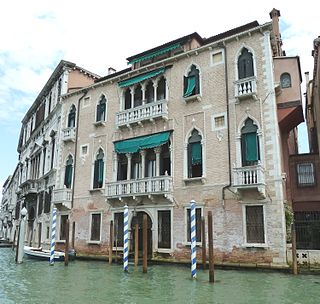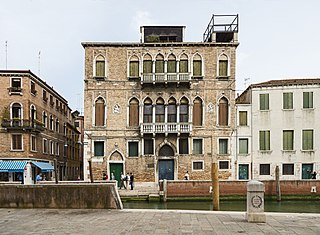
The Grand Canal is the largest channel in Venice, Italy, forming one of the major water-traffic corridors in the city.

Ca' Rezzonico is a palazzo and art museum on the Grand Canal in the Dorsoduro sestiere of Venice, Italy. It is a particularly notable example of the 18th century Venetian baroque and rococo architecture and interior decoration, and displays paintings by the leading Venetian painters of the period, including Francesco Guardi and Giambattista Tiepolo. It is a public museum dedicated to 18th-century Venice and one of the 11 venues managed by the Fondazione Musei Civici di Venezia.

Palazzo Grassi is a building in the Venetian Classical style located on the Grand Canal of Venice (Italy), between the Palazzo Moro Lin and the campo San Samuele.

The Museo Correr is a museum in Venice, northern Italy. Located in St. Mark's Square, Venice, it is one of the 11 civic museums run by the Fondazione Musei Civici di Venezia. The museum extends along the southside of the square on the upper floors of the Procuratorie Nuove. With its rich and varied collections, the Museo Correr covers both the art and history of Venice.

San Stae is a church in central Venice, in the sestiere of Santa Croce.

Museo di Storia Naturale di Venezia is a museum of natural history housed in Fondaco dei Turchi, located on the Grand Canal, Venice, Italy. Its collections relate mainly to the natural history of the Venetian lagoon that surrounds the city. Today it is one of the 11 venues managed by the Fondazione Musei Civici di Venezia.

Ca' Loredan Vendramin Calergi is a 15th-century palace on the Grand Canal in the sestiere (quarter) of Cannaregio in Venice, northern Italy. It was commissioned by the patrician Loredan dynasty, namely Andrea Loredan, and paid for by Doge Leonardo Loredan, with construction starting in 1481. The architecturally distinguished building was the home of many prominent people through history and was the place where composer Richard Wagner died.

Ettore Tito was an Italian artist particularly known for his paintings of contemporary life and landscapes in Venice and the surrounding region. He trained at the Accademia di Belle Arti in Venice and from 1894 to 1927 was the Professor of Painting there. Tito exhibited widely and was awarded the Grand Prize in painting at the 1915 Panama–Pacific International Exposition in San Francisco. In 1926 he was made a member of the Royal Academy of Italy. Tito was born in Castellammare di Stabia in the province of Naples and died in Venice, the city which was his home for most of his life.

The Palazzo Barbarigo Minotto is a 15th-century palace on the Grand Canal in Venice, northern Italy, next to the much larger Palazzo Corner. Built in the Venetian Gothic style, it was originally two palaces, Palazzo Barbarigo and Palazzo Minotto, later joined together. The Barbarigo palace was owned by the Barbarigo family for several centuries and was the birthplace of Gregorio Barbarigo, who once refused the Papal Crown. It was later owned by the Minotto and Martinengo families.

The Museo Fortuny or Fortuny Museum is an art museum in San Marco, in central Venice, Italy.
Founded following the resolution passed by the Municipal Council Board of Venice on March 3, 2008, the Fondazione Musei Civici di Venezia (MUVE) manages and develops the cultural and artistic heritage of Venice and islands. Formed as a participatory foundation, it has only one founding member, the City of Venice.

Paolo De Grandis is an Italian contemporary art curator and president of PDG Arte Communications. He lives currently in Venice.

Teodoro Francesco Maria Gasparo Correr was a Venetian abbot and art collector, most notable as the founder of the Museo Correr.

Palazzo Nani is a Renaissance palace in the Cannaregio district of Venice, Italy.

Palazzo Correr Contarini Zorzi is a Renaissance palace in Venice, Italy, overlooking the Grand Canal and locating in the Cannaregio district between Palazzo Querini Papozze and Palazzo Gritti. The palazzo is also known as Ca' dei Cuori, a family whose wrought iron coats of arms is present on the façade.

Palazzo Erizzo Nani Mocenigo is a palace in Venice located in the San Marco district and overlooking the Grand Canal between Palazzo Da Lezze and Palazzo Contarini delle Figure.

Palazzo Barbarigo Nani Mocenigo is a Gothic palace in Venice, Italy located in the Dorsoduro district, along the Nani embankment on the San Trovaso canal, near the Campo San Trovaso.

Palazzo Mocenigo Gambara is a palace in Venice, located in the Dorsoduro district and overlooking the Grand Canal, between the Contarini Palazzi degli Scrigni and Corfù and Palazzo Querini alla Carità, not far from the Gallerie dell'Accademia and in front of Palazzo Giustinian Lolin.

The Royal Palace of Venice is a complex of buildings located in the central St. Mark's Square of Venice, Italy, which served as the residence for Napoleonic viceroys, the kings of Lombardy-Venetia, Austrian viceroys, and finally, the monarchs of unified Italy. The use and successive modifications of the Royal Palace began in 1807 and ended in 1919 when King Victor Emmanuel III ceded the building to the Italian State. Currently, the complex is divided between the National Library of Venice, the Archaeological Museum, and the Correr Museum.



















